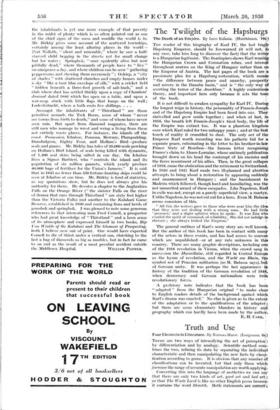Truth and Use
Four Elements in Literature. By Norman Hurst. (Longmans. 64) -THERE are two ways of intensifying the act of perceptior0
by differentiation and by analogy. Scientific method cor4- bines the two, refining its data by separating the individual characteristic and then manipulating the new facts by classj- fication according to genus. It is obvious that any number of
• classifications can be invented, but that only those which ,increase the range of accurate manipulation are worth applying. . Converting this into the language of aesthetics we can say that there are only two kinds of art, good art and bad art; or that The Waste Land is like no other English poem because it contains the' word Shanfffr. -Both' statements are-eorreer:
but the first is too general, the second too' particular, to be 'of any use. We soon find that the only categories worth having are those_ which keep similarity and difference in a balanced ratio.
Mr. Hurst has produced four categories which appear to be more truthful than useful. Indeed they fall into that class of exhausted truths known as platitudes. The labels that he has invented are Inner, Outer, Energy and Balance, and the fact that they belong to different terminologies—two spatial and two mechanical—suggests an initial confusion. To establish any liaison between the two sets it is necessary to blur what- ever particular meaning they might have. In application Inner is equated with subjective-romantic-mystic, Outer with realist-classical, Energy with didaetie-oonative and Balance with everything that lubricates awkward corners. The apparent combinations of. two, three or four elements are permitted.
It is certain that Mr. Hurst's terms are unexceptionable. Given wide enough associations they must comprise ingredients common enough in all literature._ Nor is it more than arbitrary to stop at literature ; the same terms can be worn on every occasion, for we have our reflective moods, our realist or mystic or pedagogic moments in all our works. The system in fact is fool-proof.
The only objection is that such terms are altogether too broad. With a little ingenuity everyone can lie made to fit almost any category. A strict discipline might check the worst excesses, but Mr. Hurst lacks even this. His literary criticism is; to say the least of it, commonplace. In illus- trating his elements in combination, for example, he marries Energy to Balance and produces Swift and Elizabethan love- songs in the same litter. Such a result is clearly a very rough approximation, and several stages of differentiation are needed before we reach even the results of our own unaided taste.
The test of any generalised aesthetic must surely be its ability to order and refine the individual taste. There is no point in taking the already known and codifying it in a system which merely reproduces the original data. What the critic must do is to shape an instrument which in each application
heightena.mid more elearlroutlftles-whatevei.is.contemplated. Mr. Hurst's-Elements make onty sti. very blunt-tool, knocked up roughly from the scrap of earlier criticisms. At the besi he has illustrated four labels that were already available. The terms remain descriptive, with- no sense of varying quali- ties ; they serve to set the key, to describe a temperament. At that point they stop, leaving the reader in territory which is already familiar. All that might be said about the 'kind of personality that springs from each temperament., the psycho- logical raise en scene from which temperament arises, and the intimate technical nature of the expressions proper to each, is smothered in the conventional phraseology of a very



































































 Previous page
Previous page